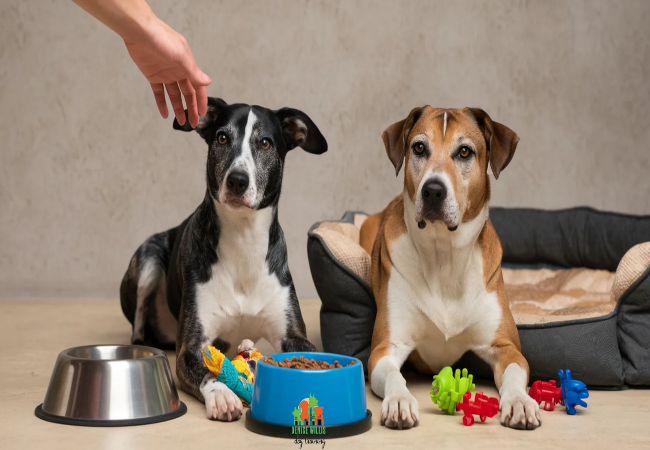Vet’s Guide to Resource Guarding in Dogs: Safely Managing Possessive Behavior 2025 🐶🦴

In this article
Vet’s Guide to Resource Guarding in Dogs: Safely Managing Possessive Behavior 2025 🐶🦴
By Dr. Duncan Houston BVSc
Hello—I’m Dr Duncan Houston BVSc, veterinarian and founder of Ask A Vet. Seeing your dog growl, stiffen, or snap over food, toys, a bed, or even your lap can be frightening. Known as resource guarding or possessive aggression, this behavior can be managed—and often reduced—when approached with empathy and structured training. In this vet‑approved guide, we’ll cover:
- 🧠 Why resource guarding is instinctual
- 📦 Early warning signs to watch
- 🚦 Step‑by‑step behavior modification
- 🛠️ Practical at‑home management
- 🔧 Supportive roles of Ask A Vet,
- 📚 A case study and FAQs to guide you
1. What Is Resource Guarding?
Resource guarding is a natural, instinctual behavior where a dog protects something they value—food, toys, locations, or people—against perceived threats. It ranges from mild (freezing, staring) to escalate aggression (growling, snapping, biting).
While often exaggerated in domestic settings, this behavior roots in survival. Even livestock guardian breeds display similar instincts to protect territory—but in pet dogs, safety and management are key.
2. Why It Happens
- 🐾 Instinct & resource scarcity: Dogs may guard when they feel their supplies are limited.
- 😟 Anxiety or insecurity, often from past trauma or inconsistent environments.
- ⚠️ Learned behavior—if growling or biting has previously succeeded in keeping others away.
- 👶 Life phase variability—often arises in young dogs, but cases persist into adulthood depending on reinforcement history.
3. Key Warning Signs
Recognizing early signs can prevent escalation:
- Pausing mid-chew, staring, stiff posture
- Growling or snarling when approached
- Snapping or lunging as intensity increases.
- Rapid resource consumption or running to “hide” items.
Studies show that owners often miss subtle signs, so vigilance is essential.
4. Behavior Modification: Step‑By‑Step
4.1 Safety First: Management
- Limit access to high-value items unless supervised.
- Feed separately or use crates/pet gates.
- Teach other pets/people to leave feeding dogs alone.
4.2 Desensitization & Counter‑Conditioning
- Start with low‑value items; approach calmly and toss a treat—no taking involved.
- Progress gradually—step closer, maintain reward pairing.
- Move to more valued resources—always pair with positive outcomes.
4.3 Teaching “Drop It” & “Leave It”
- Start with non-valued object; ask “drop it,” reward when compliance occurs.
- Use higher value items for trade—to ensure dropping feels rewarding.
4.4 Avoid Forced Takeaway
Physically taking away items reinforces the dog’s fear and ownership anxiety.
5. At‑Home Tips & Tools
- Ask A Vet App: Share videos of guarding episodes and receive tailored behavior plans.
- Structured routines: Scheduled meals, toy rotation, clear boundaries.
6. Real Dog Case Study
Case: “Julius,” 2‑year‑old Terrier mix
Julius would lunge and growl when another dog approached him during toy time. We began desensitization using low-value toys—dropping treats when a human approached. Over weeks, we worked up to his favorite plush. We taught “drop it” on cue paired with high-value treats. Crate feeding and supervised play set safety. With Ask A Vet guidance, Julius now drops toys on request with calm, reserved guarding limited to puppy-chew items only.
7. FAQs
- Can resource guarding go away entirely? Many dogs adapt well—food guarding is often extinguished, while toy guarding may become manageable with consistent training.
-
Is it always aggression?
No—often rooted in anxiety. Early signs include staring and stiffness—not always threatening. -
Can kids be around a resource guarding dog?
Only under close supervision, with easily replaceable toys—never leave a child alone near guarding behavior. -
When should I get professional help?
If snapping, biting, or guarding escalates, consult a certified trainer or veterinary behaviorist.
📌 Final Thoughts from a Vet
Resource guarding is a natural, manageable behavior—not a flaw. By understanding your dog’s triggers, watching for early signals, and applying consistent, gentle training, you can reduce conflict and strengthen trust. Integrating tools like Ask A Vet telehealth. With care and planning, you’ll help your dog feel secure—making sharing safe and stress-free for both of you. 🐾❤️






